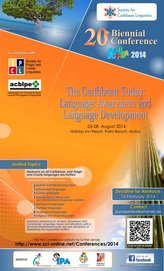What do Aruba, Bonaire and Curaçao have in common with Malacca? Historical and linguistic links between Papiamentu and Papiá Kristang.
Marco Aurelio Schaumloeffel
Handout
Handout SCL 2014 – Marco Schaumloeffel
Prezi Presentation
Abstract
Abstracts SCL 2014 (p. 56)
References
References used to prepare presentation
What do Aruba, Bonaire and Curaçao have in common with Malacca? Historical and linguistic links between Papiamentu and Papiá Kristang.
The discussion on the origin of Papiamentu (PA) still is controversial, since it is classified by some scholars as a Spanish Creole and by others as a Portuguese Creole. However, recent historical and linguistic evidence trace back its origins to West African Portuguese creoles (Jacobs 2012, among others). This leaves little space to speculate if PA owes its origins to a variety or varieties of Spanish, but there still are many scholars who claim that PA is supposedly of Spanish origin.
The aim of this paper is to provide further evidence in favour of the Portuguese origin of PA by doing a unique investigation on the historical and linguistic links existing between PA and Papiá Kristang (PK). Historical links set the context, but linguistic data is naturally the most reliable evidence of possible genetic ties between creoles. At the first instance, it seems strange to compare a Portuguese creole developed in Southeast Asia with another creole spoken in former Dutch colonies in the Caribbean, since they apparently are worlds apart.
Nevertheless, PK can ideally be used in this context, since it is a well-known and studied Portuguese creole that has virtually no Spanish influence. And if there is virtually no Spanish influence in PK, then the comparison between PA and PK may be an ideal tool to establish if PA really carries Portuguese features. Only a careful analysis can reveal if grammatical similarities are present in the structural fabric of both creoles.
The linguistic features that PA shares with PK will be analysed and compared in this paper through four relevant aspects of grammatical categories: Formation and use of TMA markers (Tense, Mood, Aspect), the multifunctionality of the lexical item ‘ku’, word reduplication and its grammatical functions, and analysis of two auxiliary verbs.
The evidence indicates that the origins of PA cannot be comprehensively analysed and understood if vital historical and linguistic links to the Portuguese language are ignored. These ties were formed via West Africa and the Portuguese creoles spoken there, and possibly also influenced by the immigration of Sephardic Jews and their servants from Dutch Brazil to Curaçao. Despite not being genetically linked to West African Portuguese creoles, but because it is a Portuguese creole undoubtedly unrelated to Spanish, PK acts as an ideal tool of comparison in this case. As result, this paper definitively refutes any hypothesis that excludes the fundamental role of Portuguese and Portuguese creoles in the formation of PA.
